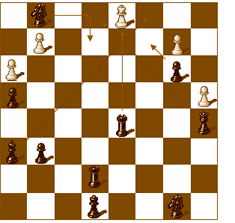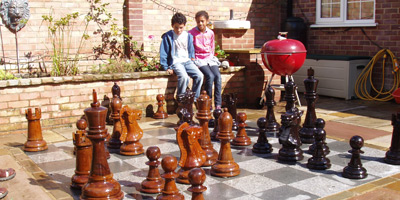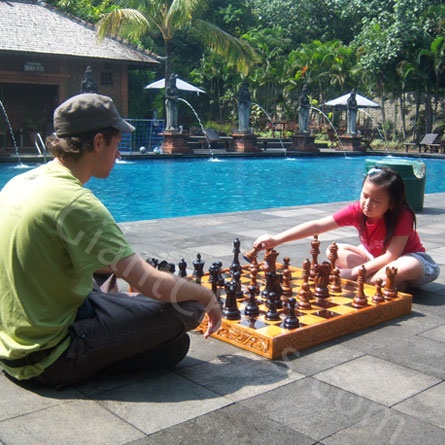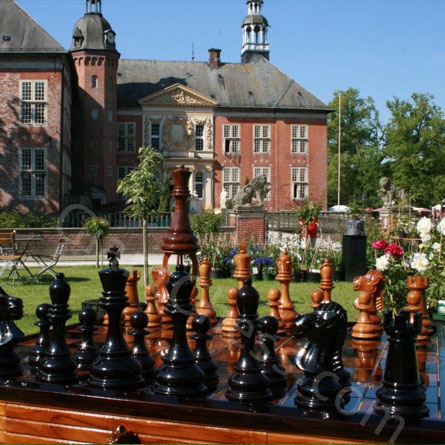- Written by
- Published:
 Chess - or the forerunner of the Modern Chess - is believed to have originated in India in the 6th century as a game of war, played by the upper castes, in which the pieces were divided into four military groupings: infantrymen (represented by the modern pawn; see below); cavalry (represented by the modern knight, shaped like a horse; also see below); elephant (represented, at least in its movements, by the modern bishop; and war chariot (represented by the modern rook). From India the game went to Persia where its name was derived from the familiar Persian word Shah, originally meaning, as was the Indian word for this game, King, from which derives the modern word Chess.
Chess - or the forerunner of the Modern Chess - is believed to have originated in India in the 6th century as a game of war, played by the upper castes, in which the pieces were divided into four military groupings: infantrymen (represented by the modern pawn; see below); cavalry (represented by the modern knight, shaped like a horse; also see below); elephant (represented, at least in its movements, by the modern bishop; and war chariot (represented by the modern rook). From India the game went to Persia where its name was derived from the familiar Persian word Shah, originally meaning, as was the Indian word for this game, King, from which derives the modern word Chess.
From Persia the game found its way north by a number of routes until in the year 1000 it was being played throughout Europe - from the Iberian peninsula in the West, where it was introduced by the Moors, to the Russian cities of the East, where it would later produce, as is still the case today, the greatest players in the world, and where Chess, consequently, is considered as much a sport as it is a game.
Chess is a game of war between two armies, one of sixteen white pieces and one of sixteen black pieces, at the start arranged in two rows at opposite ends of the chessboard standing face to face. One chess piece can occupy only one space. In the front row of each side are the eight Pawns, followed in the back row by two Rooks at the ends; next to them the two Knights; then come the Bishops; and at the center the King and Queen, with the Queen on her own color. The Chessboard consists of 64 squares, alternating in black and white, with a white square, by international standard, on the far right of the first row for both sides. The player who controls the white pieces moves first
General Rules of Chess Game
The main purpose in a game of chess is to try to kill, or in chess terms "checkmate," the opponent’s King. To accomplish this, the player must carefully plan to undermine and then attack the king's position. The first move is made by the player with the white pieces and the second move by the player with the black pieces. Every chess piece moves differently (please SEE below). A chess piece can move to another position or can capture one of the opponent’s chess pieces by moving one of his pieces to its square. Except for the Knight, chess pieces cannot move by jumping over other chess pieces that stand in their way.1. Chessboard
In addition to the 32 pieces needed to play Chess - 2 Kings, 2 Queens, 4 Rooks, 4 Bishops, 4 Knights, and 16 pawns, divided equally between the two players and placed directly opposite each other - the equipment most necessary to begin a game is the chessboard. The chessboard is square with alternating squares of black and white. By international agreement, the square at the front right-hand side of the board for each player should be white. The 64 white and black squares can be considered as aligned in horizontal rows and vertical columns, as well as diagonal lines were pieces can move in straight line along one color.2. Pawn
 The Pawn is the least powerful of all chess pieces, but very important in combination with other Pawns for defense, as well as for advancing into one's opponent's territory. The Pawn’s direction is usually straight ahead one square per turn. But from its original position, it may be moved forward either one or two squares as long as there is no obstructing piece. Pawns cannot move backward. The Pawn can capture another piece by moving forward one diagonal space, but cannot take the piece directly in front of it. There is one other way the pawn can capture, it is called:
The Pawn is the least powerful of all chess pieces, but very important in combination with other Pawns for defense, as well as for advancing into one's opponent's territory. The Pawn’s direction is usually straight ahead one square per turn. But from its original position, it may be moved forward either one or two squares as long as there is no obstructing piece. Pawns cannot move backward. The Pawn can capture another piece by moving forward one diagonal space, but cannot take the piece directly in front of it. There is one other way the pawn can capture, it is called:
- En Passant
Any time a player has a Pawn on the fifth row in front of him, and the other player tries to pass next to it by moving a pawn two spaces forward from his second row to the fourth, the player can take that piece as if it had moved to the third row, by moving one diagonal space forward behind it. This is called taking "en passant" (in passing) and must be done immediately on one's next turn or the option is forfeited.- Pawn Promotion
Besides En Passant, the Pawn has one other special ability; it is called Promotion. Promotion of a Pawn (black or white) to a more powerful piece can be accomplished, although with great difficulty, if it manages to reach the eighth row. At that moment, the player who has moved the pawn there can ask his opponent to exchange it for a more powerful piece, although not to another king). Most players will choose another Queen (or to replace one that was lost) because it is the most powerful piece; but on rare occasion it can be right to ask for a different piece, such as a knight that might be able to check an opponent's king where even a queen couldn't.3. Heroic
A. Rook
 The Rook is one of the heroic chess pieces and can have a big influence in a chess game. If the Rook is paired with another Rook, or the Queen, these are among the most powerful of all attacking combinations in Chess.
The Rook is one of the heroic chess pieces and can have a big influence in a chess game. If the Rook is paired with another Rook, or the Queen, these are among the most powerful of all attacking combinations in Chess.
The Rook can move in a straight line along any column or row as long as there is no barrier. The direction of capture is the same, by landing on the same square as an opponent's piece. The Rook may not move in a diagonal line.
- Castling
 If En Passant and Promotion are the special abilities of the Pawn, then Castling is the special ability of the rook, shared with King (see diagram) but can only be done if:
If En Passant and Promotion are the special abilities of the Pawn, then Castling is the special ability of the rook, shared with King (see diagram) but can only be done if:* There is no other pieces between King and Rook.
* King and Rook are still in original position and have never been moved.
* The King isn't in a position threatened by "check," or would be moving past such a threat.
The purpose of Castling is generally to protect one's King and create opportunity for the Rook to get into the field of play. When Castling, the King should be moved first, then the Rook. Unlike the king, a rook that is threatened by another piece can still participate in castling, and can, as well pass through a position where it would be threatened where the king in castling cannot.
B. Knight
 The Knight is the only piece that is able to pass over another chess piece. The directional movement of the Knight is based on the letter L. At each moving opportunity, the Knight has potentially eight squares it can move to or capture at.
The Knight is the only piece that is able to pass over another chess piece. The directional movement of the Knight is based on the letter L. At each moving opportunity, the Knight has potentially eight squares it can move to or capture at.
The intricate jumping moves of this heroic piece often confuse the beginning player.
C. Bishop
 The direction the Bishop moves is diagonal. Each player has two Bishops to begin the game, one on a white square the other on a black square. The Bishop that is on the white square always moves diagonally on white squares. The Bishop that is on the black square always moves diagonally on black squares. Because the diagonal squares are all of the same color, it is impossible for the Bishop located on a white square to be moved to a black square, or, conversely, for a Bishop located on a black square to be moved to a white square.
The direction the Bishop moves is diagonal. Each player has two Bishops to begin the game, one on a white square the other on a black square. The Bishop that is on the white square always moves diagonally on white squares. The Bishop that is on the black square always moves diagonally on black squares. Because the diagonal squares are all of the same color, it is impossible for the Bishop located on a white square to be moved to a black square, or, conversely, for a Bishop located on a black square to be moved to a white square.
D. Queen
 The most powerful chess piece is the Queen. This is because the Queen can move an unlimited number of squares in any direction. It means that she can move to threaten or capture from any position, moving straight or diagonally. The only thing she cannot do is jump over pieces, as can the knight.
The most powerful chess piece is the Queen. This is because the Queen can move an unlimited number of squares in any direction. It means that she can move to threaten or capture from any position, moving straight or diagonally. The only thing she cannot do is jump over pieces, as can the knight.
Losing this piece is the most devastating blow in chess a player can face.
E. King
 Though the king is not nearly as powerful as one might expect from its title - only able to move one square at a time in any direction, and not where it is threatened by check - the two kings unable to meet at any time during the game for this reason - its position is vital to the game, and if not successfully defended all is lost. Only at the end of the game (see Endgame), when most of the powerful attacking pieces have been exchanged or lost, does the king's one-square-at-a-time pace take on importance.
Though the king is not nearly as powerful as one might expect from its title - only able to move one square at a time in any direction, and not where it is threatened by check - the two kings unable to meet at any time during the game for this reason - its position is vital to the game, and if not successfully defended all is lost. Only at the end of the game (see Endgame), when most of the powerful attacking pieces have been exchanged or lost, does the king's one-square-at-a-time pace take on importance.
End Game
 The End game in chess is that part of the game, following the Opening and Middle Game, when most of the more powerful pieces have been exchanged and the position of the pawns in relation to the king - up to this point of secondary nature - becomes supremely important, including the possibility of a player getting one of his pawns to the eighth row and having it promoted to a queen. The game that has previously been strategic and attacking now becomes positional, with the possibility of patiently exploiting even the smallest advantage that might have been gained during opening play.
The End game in chess is that part of the game, following the Opening and Middle Game, when most of the more powerful pieces have been exchanged and the position of the pawns in relation to the king - up to this point of secondary nature - becomes supremely important, including the possibility of a player getting one of his pawns to the eighth row and having it promoted to a queen. The game that has previously been strategic and attacking now becomes positional, with the possibility of patiently exploiting even the smallest advantage that might have been gained during opening play.
The Endgame is also the part of the game when both players may discover that neither has enough of an advantage, or even sufficient material, to proceed to a win. At which point both players may concede a draw (tie), or one player may offer a draw, and the other player may accept. If either player is unwilling to relinquish the possibility of winning, there are other conditions by which the game can result in a draw other than Stalemate (SEE previous section). One is Perpetual Check, in which a player continually places his opponent's king in check, but not mate, so that neither player can proceed to a win. Another is when the same identical position has been reached three times, including by perpetual check. And finally, if there are fifty consecutive moves when no pawn has been moved and no piece taken, then the game automatically comes to and end and is declared a draw.














